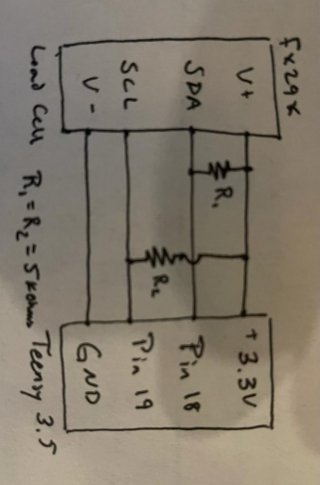Hi all,
What I keep running into is that my I2C load cell sensor will return values that don't make any sense. Sometimes 0, sometimes 2000, sometimes 14000, etc (it should be ~800-1000 with no load). If I short the connection between SCL/SDA everything starts to work as it should. It continues to work until the Teensy is unplugged.
I'm working on using a Teensy 3.5 read data in from a load cell connected via I2C. The load cell that I am using is FX29K0-100A-0025-L. The relevant datasheet is here.
The load cell is powered off of 3.3V from the Teensy. I am using pins 18 and 19 for the standard SCL/SDA.
I'm using external 5 kOhm pull-up resistors. I've tried several different resistance values (1k, and 10k) with no real changes.
I've tried using the Wire.resetBus() function in the setup with no luck. I've found the best clock frequency (the one that works) is 100kHz. I've tried polling the sensor with the IntervalTimer at lower and higher frequencies. I've tried inserting delays many spots, but haven't found the right spot or timing I guess.
I've tried using both the Wire.h library and the i2c_t3.h library with similar results. I've never worked with I2C before, so I am hoping I am missing something simple. I'm using windows 10.
Here is the schematic of the circuit
Here is the code I am using within teensyduino:
What I keep running into is that my I2C load cell sensor will return values that don't make any sense. Sometimes 0, sometimes 2000, sometimes 14000, etc (it should be ~800-1000 with no load). If I short the connection between SCL/SDA everything starts to work as it should. It continues to work until the Teensy is unplugged.
I'm working on using a Teensy 3.5 read data in from a load cell connected via I2C. The load cell that I am using is FX29K0-100A-0025-L. The relevant datasheet is here.
The load cell is powered off of 3.3V from the Teensy. I am using pins 18 and 19 for the standard SCL/SDA.
I'm using external 5 kOhm pull-up resistors. I've tried several different resistance values (1k, and 10k) with no real changes.
I've tried using the Wire.resetBus() function in the setup with no luck. I've found the best clock frequency (the one that works) is 100kHz. I've tried polling the sensor with the IntervalTimer at lower and higher frequencies. I've tried inserting delays many spots, but haven't found the right spot or timing I guess.
I've tried using both the Wire.h library and the i2c_t3.h library with similar results. I've never worked with I2C before, so I am hoping I am missing something simple. I'm using windows 10.
Here is the schematic of the circuit

Here is the code I am using within teensyduino:
Code:
#include <i2c_t3.h>
// Load Cell
int wire_in = 40; //0x28 from data sheet
uint8_t bridge_data[2] = {0}; //2 bytes to pull data from sensor
bool force_flag = false;
int force_counts = 0;
// Teensy3.5 pins 19 SCL, 18 SDA
// Teensy3.5 requires external pullup resistors ~4.7kOhm
// FX29 Red (V+), Black (V-), Yellow (SCL) (19), White (SDA) (18)
// Timer to call function at specific frequency
IntervalTimer forceDataTimer;
// RawHID Print Buffer:
byte print_buffer[64];
int buffer_count = 0;
byte f_data = 0x46; //'F'
void setup() {
pinMode(LED_BUILTIN, OUTPUT);
delay(100);
//I2C Interface: Load cell
// Wire.begin();
// Wire.setClock(100000);
// delay(1000);
// Wire.beginTransmission(wire_in); //get ready to tell sensor we want data
// Wire.write(0); //tell sensor we want data
// Wire.endTransmission();
// delay(1000); //wait for it to come alive
Wire.begin(I2C_MASTER, 0x00, I2C_PINS_18_19, I2C_PULLUP_EXT, 100000);
delay(1000);
//Get force data interupt
forceDataTimer.begin(getForceISR, 2000); //2000us = 500hz
}
void loop() {
// Load Cell Main Loop
if (force_flag) {
print_buffer[buffer_count] = f_data;
print_buffer[buffer_count+1] = bridge_data[0];
print_buffer[buffer_count+2] = bridge_data[1] & 0x3f;
buffer_count+=3;
force_counts = (bridge_data[0] << 8 | bridge_data[1]) & 0x3fff;
force_flag = false;
}
if (buffer_count >= 61) {
for (int i=buffer_count+1; i<63; i++) {
print_buffer[i] = 0;
}
RawHID.send(print_buffer, 100);
// Serial.println(force_counts);
buffer_count = 0;
}
}
// Force I2C interrupt routine
void getForceISR() {
if (!force_flag) {
digitalWrite(LED_BUILTIN, HIGH);
Wire.beginTransmission(wire_in); //get ready to tell sensor we want data
Wire.write(0); //tell sensor we want data
Wire.endTransmission();
int ec = Wire.requestFrom(wire_in, 2); //request two bytes of data
if (ec==0) {
Serial.println("Device not responding");
}
else {
// bridge_data[0] = Wire.read();
// bridge_data[1] = Wire.read();
Wire.read(bridge_data, Wire.available());
}
force_flag = true;
digitalWrite(LED_BUILTIN, LOW);
}
}
